
Consumer Insights
Uncover trends and behaviors shaping consumer choices today
Procurement Insights
Optimize your sourcing strategy with key market data
Industry Stats
Stay ahead with the latest trends and market analysis.
The global automated fare collection market size was at USD 13.24 Billion in 2025, driven by growing integration of mobile payment solutions. The industry is expected to grow at a CAGR of 12.50% during the forecast period of 2026-2035 to attain a value of USD 42.99 Billion by 2035. Automated fare collection systems boost efficiency by lowering passenger wait times and operational costs through streamlined manual processes.
Base Year
Historical Period
Forecast Period
As reported by the Government of Dubai, in 2023, the city added 1,160 taxis to its fleet, bringing the total number of vehicles to around 12,532. Automated fare collection solutions streamline payment processes, reduce cash handling, and improve operational efficiency. This supports the global market by showcasing the increasing adoption of advanced payment technologies in expanding transportation networks, enhancing user convenience and service scalability.
The Department of Transport UK noted that public road transport—including tramways, trolleybuses, and buses—increased by 23% from 2000 to 2022, reaching a total of 4.2 billion person-kilometers. This highlights the growing demand for efficient and scalable fare collection systems. Automated fare collection technologies help manage this surge by providing seamless, contactless payment solutions, reducing congestion, and enhancing operational efficiency.
The Australian Bureau of Statistics indicates that the growth of the recreational vehicle rental market in Australia is linked to the 20.1 million registered motor vehicles as of January 31, 2021. Automated fare collection systems are essential for managing diverse transportation modes, including rentals, by enabling contactless, streamlined payments. This trend supports the global market by promoting wider adoption of automated payment solutions across various transport sectors.
Compound Annual Growth Rate
12.5%
Value in USD Billion
2026-2035
*this image is indicative*
Automated fare collection is an innovative payment method for public transportation systems. It allows travelers to access various transport modes, such as buses and taxis, using tickets to navigate automated electronic systems. This method ensures reliable and efficient payment solutions for government transport, as well as for rail, parking, and theme parks, contributing to the growth of the automated fare collection market. In India, digital transactions totaled USD 1,601.98 million in 2022-23, according to the Reserve Bank of India (RBI).
Automated fare collection systems improve transit efficiency by simplifying processes and decreasing wait times. The demand for the automated fare collection market is driven by their ability to reduce operational costs through less manual ticketing and cash handling, enhance accuracy by minimising human error, and provide convenience with various payment options, such as contactless cards and mobile payments, resulting in faster transactions for passengers. According to industry reports from 2023, digital wallets were significantly more common in the Asia-Pacific region than elsewhere, accounting for 70% of e-commerce payments in that area.
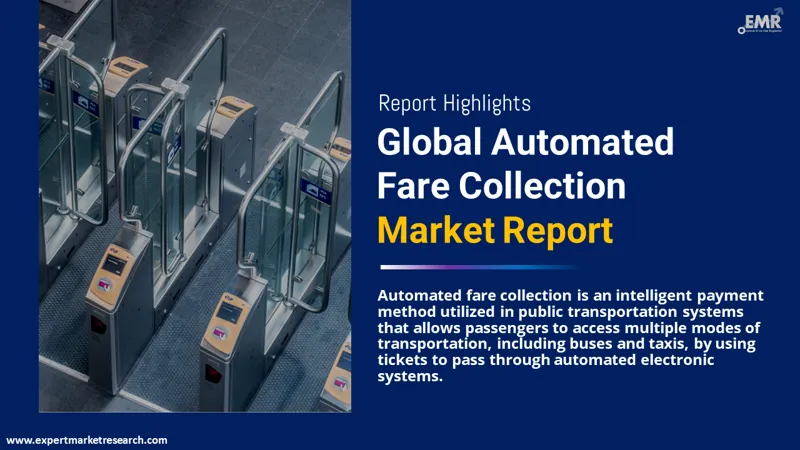
Read more about this report - REQUEST FREE SAMPLE COPY IN PDF
Automated fare collection systems boost efficiency by lowering passenger wait times and operational costs through streamlined manual processes. They enhance revenue by reducing fare evasion and ensuring accurate transactions. The decreased reliance on paper tickets and cash transactions supports environmental sustainability by minimizing waste, creating several opportunities in the automated fare collection market. In July 2024, Amazon Pay partnered with Delhi Metro Rail Corporation (DMRC) to allow commuters to book and generate digital QR tickets online, eliminating the need for physical tokens that typically take around 15 minutes to produce and are often lost during travel.
Automated fare collection (AFC) systems provide scalability to accommodate rising ridership and integrate new technologies. They facilitate smooth transitions across different modes of transportation, enhancing connectivity. Furthermore, their convenience and efficiency enhance the overall customer experience, resulting in greater ridership and higher customer satisfaction, thereby boosting the automated fare collection demand. In China, the volume of electronic transactions processed by commercial banks rose in 2023, with mobile payment transactions increasing by 16.81% year-over-year, totaling 1,851.47 billion, according to the People’s Bank of China.
Integration of mobile payments, interoperability across transport modes, and government initiatives and support are increasing the automated fare collection market value.
A notable trend in the automated fare collection market is the growing integration of mobile payment solutions. Commuters increasingly prefer the convenience of using smartphones for transactions, which has led to the rise of digital wallets and contactless payment methods. This transition improves the user experience, decreases reliance on cash, and accelerates the fare collection process. Transit agencies are collaborating with fintech companies to create secure, user-friendly applications, allowing passengers to easily pay for their journeys while benefiting from loyalty programs and real-time fare information, thus boosting automated fare collection market revenue. According to the US Census Bureau, retail sales in the U.S. have shown consistent growth, with e-commerce sales rising from USD 266,314 million in Q1 2023 to USD 289,204 million in Q1 2024.
Interoperability among various transportation systems is emerging as a significant trend of the automated fare collection market. By enabling passengers to use a single payment method for multiple transit modes such as buses, trains, and trams agencies improve the overall travel experience. This seamless integration simplifies fare systems and promotes increased public transport usage. Initiatives to establish unified fare systems are gaining traction, with some regions adopting smart cards or mobile apps that work across different transit operators, ultimately fostering a more interconnected and efficient transportation network. According to Eurostat, public transport usage in the EU grew by 12% in 2022, reaching approximately 53 billion passenger journeys, fueled by improved service availability and sustainable transport efforts.
Sustainability is increasingly shaping the automated fare collection market dynamics and trends. To reduce their environmental impact, transit authorities are adopting paperless ticketing solutions like mobile tickets and smart cards to decrease waste. Additionally, eco-friendly practices, such as recycling old ticketing equipment and using energy-efficient technologies, are becoming standard. This transition aligns with global sustainability goals and appeals to environmentally conscious consumers. Given that public transportation is vital for alleviating urban congestion and emissions, automated fare collection systems focusing on sustainability are likely to experience greater adoption. In October 2023, NEC Corporation and Sumitomo Corporation received an order from Hitachi Rail STS S.p.A. to supply Communication Systems and an Automated Fare Collection System for the North-South Commuter Railway (NSCR) being developed by the Philippine Department of Transportation. Drawing on its international expertise in constructing Communication Systems and Automated Fare Collection Systems, NEC will work with partner companies on the design, development, manufacturing, equipment procurement, installation, testing, and commissioning of these systems.
Government support plays a crucial role in the growth of the automated fare collection market. In recent years, many governments have prioritised the development of smart cities and the modernisation of public transport networks. For instance, Singapore's Land Transport Authority has been investing heavily in digitalisation, with the implementation of its "SimplyGo" system that allows commuters to tap their bank cards or mobile phones to pay fares, enhancing convenience. Similarly, the UK’s Transport for London (TfL) has introduced contactless payment methods for buses and trains, streamlining payment processes for millions of passengers. These initiatives are aimed at improving operational efficiency, reducing the need for cash handling, and minimising fare evasion. Furthermore, such systems support the wider goal of reducing traffic congestion and pollution by encouraging the use of public transport, ultimately contributing to more sustainable urban mobility.
Automated fare collection (AFC) systems significantly enhance operational efficiency for transport operators by optimising routes, reducing fare evasion, and streamlining financial management. With real-time data analytics, these systems enable operators to monitor passenger flows, adjust routes, and optimise schedules to better align with demand patterns. For example, by analysing peak travel times, transport authorities can adjust bus and train frequencies, ensuring resources are allocated efficiently and reducing wait times for passengers.
One of the key benefits of AFC systems is their ability to minimise fare evasion. In cities like New York, where the Metropolitan Transportation Authority (MTA) has introduced contactless payment methods, fare evasion has decreased due to the ease of tracking payments through digital transactions. By reducing cash handling and implementing real-time verification, these systems ensure that fares are properly collected, resulting in higher revenue.
The automated fare collection market faces several key restraints. High initial investment costs for technology and infrastructure can deter transit authorities, particularly in budget-constrained areas. Integrating new systems with legacy infrastructure poses challenges, while data security concerns can hinder user adoption. Additionally, varying user acceptance levels, particularly among older demographics, complicate implementation.
Regulatory compliance can be complex, and ongoing maintenance costs add financial strain. Dependence on technology increases vulnerability to disruptions, and inadequate infrastructure in some regions limits effective deployment, further hindering the growth of automated fare collection industry.
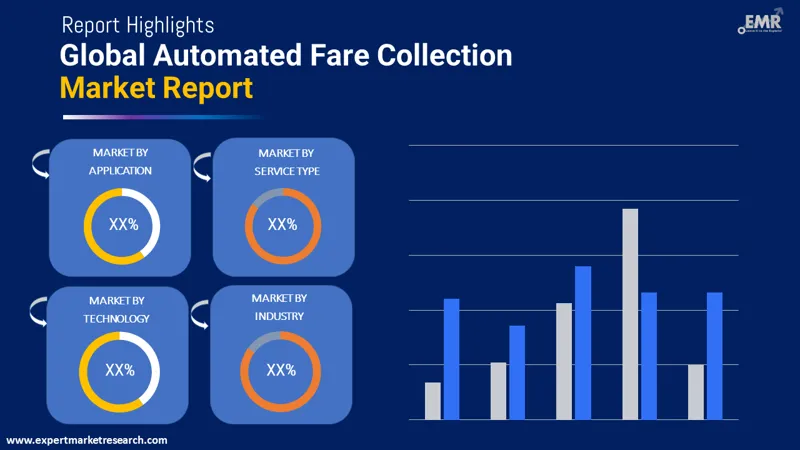
Read more about this report - REQUEST FREE SAMPLE COPY IN PDF
The EMR’s report titled “Automated Fare Collection Market Report and Forecast 2026-2035” offers a detailed analysis of the market based on the following segments:
Market Breakup by Application
Market Breakup by Service Type
Market Breakup by Technology
Market Breakup by Industry
Market Breakup by Region
Market Analysis by Application
As per the automated fare collection market analysis, automated fare collection in rail and transport boosts efficiency by simplifying ticketing and cutting wait times, resulting in a better passenger experience. It reduces operational costs by limiting manual processes and labor needs. These systems enhance revenue capture by decreasing fare evasion and offer user convenience with various payment options. They also gather valuable data to guide operational decisions and improve services. In 2023, Aurionpro introduced an Automated Fare Collection (AFC) system for the Noida Metro project in India, automating fare collection and ticket sales across multiple public transport modes, including metro trains, buses, and boats, improving overall efficiency.
Automated fare collection systems in theme parks simplify entry processes, minimizing queues and boosting visitor satisfaction. They provide flexible payment options for convenient transactions and enhance revenue management by tracking sales in real-time, reducing fraud, and enabling dynamic pricing. Integration with loyalty programs fosters customer engagement, while automation improves operational efficiency, resulting in cost savings and valuable data insights for effective crowd management, impacting the demand of the automated fare collection market. In September 2023, Disney Parks announced the launch of a new automated fare collection system that allows guests to buy tickets and access attractions via mobile apps and contactless payment options.
Market Analysis by Technology
NFC technology improves automated fare collection by facilitating rapid transactions with a simple tap of devices or cards, accelerating processes. It enables contactless payments, enhancing hygiene in busy environments, which contributes to growth in the automated fare collection market. Users enjoy various payment options, including mobile wallets, while NFC provides increased security through encryption. Additionally, it enables real-time data collection on passenger behavior, supporting operational decision-making. In October 2023, Transport for London (TfL) introduced an upgraded automated fare collection system utilizing NFC technology, allowing passengers to tap their smartphones or NFC-enabled cards for smooth entry and exit throughout the transit network.
Magnetic stripe cards offer a cost-effective solution, making them an economical option for transit agencies. Their straightforward design enables passengers to easily swipe cards, leading to faster transactions and shorter wait times. This technology is compatible with existing systems, facilitating smoother transitions to automation driving the automated fare collection demand growth. Magnetic stripes also store critical data for fare management and have proven reliability, reducing implementation risks. In November 2023, Suburban Rail introduced magnetic stripe cards for fare collection, improving the user experience with simple card swipes at stations, promoting budget-friendly transit options, and enhancing revenue management while integrating well with current infrastructure.
Market Analysis by Industry
The growth of the automated fare collection market is enhanced the media and entertainment sector by streamlining access to events, which significantly shortens wait times and improves visitor experiences at concerts and theme parks. Flexible payment options, such as mobile apps and contactless cards, ensure convenience. Real-time tracking reduces fraud, supports dynamic pricing, and provides valuable insights into consumer preferences, optimizing marketing strategies and encouraging customer loyalty through personalised promotions. The Australian Bureau of Statistics reported that film and video production businesses achieved the highest total income of $4,575.3 million in Australia in 2023.
The demand for automated fare collection market is further impacted by the retail sector by accelerating transactions, decreasing checkout times, and enhancing customer satisfaction. These systems support contactless payments, improving hygiene and safety. Their integration with loyalty programs allows retailers to offer personalised discounts, increasing engagement. Additionally, real-time data collection on purchasing patterns aids inventory management and leads to substantial cost savings by reducing cash handling. According to the Australian Bureau of Statistics, retail trade in Australia rose by 2.3% from July 2023 to July 2024, reaching USD 36,160.1 million in July 2024.
Europe Automated Fare Collection Market Analysis
Europe is witnessing a notable increase in the automated fare collection demand, particularly in Germany, Italy, and France. In August 2023, BVG (Berliner Verkehrsbetriebe) introduced an upgraded automated fare collection system in Berlin that incorporates mobile ticketing and contactless payment methods, simplifying access to public transport for commuters and supporting sustainability initiatives.
North America Automated Fare Collection Market Trends
The North American automated fare collection market value is poised for significant growth, driven by leading brands like Cubic Transportation Systems, Masabi and Genfare. Automated fare collection systems gather data on ridership patterns, aiding decision-making and service optimisation, while enhancing security by reducing cash transactions and using encryption to prevent fraud. In August 2023, LA Metro upgraded its fare collection system, integrating contactless payment options and mobile ticketing to enhance rider convenience and streamline the boarding process.
Asia Pacific Automated Fare Collection Market Insights
In India brands such as Aurionpro Solutions, Siemens and Cubic Transportation Systems highlight the growing automated fare collection market share in the Asia-Pacific region. In India, interoperability is emphasised, with many AFC systems designed to function across different transit modes, allowing for seamless transfers and improving the overall travel experience. In January 2024, new Automated Fare Collection (AFC) gates were installed at the Esplanade metro station in Kolkata, incorporating updated technology.
Latin America Automated Fare Collection Market Analysis
Key markets in the region include Brazil, Mexico, and Argentina, where there is significant demand for automated fare collection market. AFC systems enhance user convenience with various payment options for quick transactions, while also collecting valuable data on ridership patterns to help transit agencies optimise services. In 2023, Mexico City introduced an upgraded automated fare collection system for its metro network, enabling contactless payments and mobile ticketing options to enhance commuter convenience.
Middle East and Africa Automated Fare Collection Market Driving Factors
The African automated fare collection market is experiencing growth, particularly in Egypt, Ethiopia, and Morocco. AFC systems enhance financial inclusion by integrating with mobile money platforms, allowing users without bank access to transact digitally, while promoting sustainability through cashless transactions and reduced paper ticket usage. In September 2023, the City of Cape Town announced the rollout of an upgraded automated fare collection system for its MyCiTi bus service.
Innovative startups in the automated fare collection market enhance user experience with mobile apps and real-time tracking, increase efficiency through automation, and leverage data analytics for insights. They foster integration across transport modes, improve security with advanced technologies, and promote sustainability by encouraging public transport use. Additionally, their customizable and scalable solutions optimize revenue collection and support inclusivity, ultimately transforming public transport to be more efficient and user-friendly.
Transit App (2024): Transit App enhances urban mobility by integrating real-time transit information and multi-modal payment solutions. Users can easily navigate public transportation options and pay fares seamlessly through their smartphones, improving overall travel convenience and encouraging more people to utilize public transit.
BlockFare (2024): BlockFare leverages blockchain technology to create secure, transparent fare collection systems. By reducing fraud risks and enhancing transaction security, the startup builds trust among users and transit authorities, streamlining the payment process while providing a reliable and efficient solution for modern transit needs.
Key players in the automated fare collection market focus on developing advanced technology solutions for transportation and communication, offering innovative products like automatic ticketing systems and traffic management solutions. Serving public transportation, road management, and airport operations, these companies enhance mobility and safety. Committed to quality and innovation, they aim to expand globally while delivering solutions that improve operational efficiency and user experiences in transit systems worldwide.
Advanced Card Systems Ltd.: Based in Hong Kong and established in 1995, Advanced Card Systems Ltd. focuses on smart card technology and automated fare collection. The company provides innovative solutions that enhance secure transactions across various sectors, particularly in transportation and access control, improving user convenience and operational efficiency through advanced payment systems.
Cubic Corporation: Founded in 1951 and headquartered in San Diego, California, Cubic Corporation is a leader in transportation and defense solutions. The company is recognized for its automated fare collection systems, utilising cutting-edge technology to enhance public transit efficiency and improve user experiences, driving innovation in smart mobility and secure defense applications.
LG CNS: Established in 1987 and based in Seoul, South Korea, LG CNS is a subsidiary of LG Corporation that specializes in IT services, including automated fare collection systems. By leveraging advanced technologies like AI and big data, the company aims to optimise public transportation, enhancing operational efficiency and user experience across various industries.
Atos SE: Headquartered in Bezons, France, was established in 1997 and is a multinational IT services company. Specializing in digital transformation, it focuses on automated fare collection and smart mobility solutions. Atos integrates innovative technologies to enhance public transportation efficiency and security, aiding transit authorities in improving operations and passenger experiences.
*Please note that this is only a partial list; the complete list of key players is available in the full report. Additionally, the list of key players can be customized to better suit your needs.*
Other market key players in automated fare collection market report are Singapore Technologies Engineering Ltd, Nippon Signal Co., Ltd., Thales SA, LECIP HOLDINGS CORPORATION, NXP Semiconductors N.V., OMRON Corporation, SAMSUNG SDS America, Inc., and Scheidt & Bachmann GmbH among others.




*While we strive to always give you current and accurate information, the numbers depicted on the website are indicative and may differ from the actual numbers in the main report. At Expert Market Research, we aim to bring you the latest insights and trends in the market. Using our analyses and forecasts, stakeholders can understand the market dynamics, navigate challenges, and capitalize on opportunities to make data-driven strategic decisions.*
Get in touch with us for a customized solution tailored to your unique requirements and save upto 35%!
In 2025, the automated fare collection market reached an approximate value of USD 13.24 Billion.
The market is assessed to grow at a CAGR of 12.50% between 2026 and 2035.
The market growth is driven by the growing use of cashless fare collection systems in the transportation sector worldwide, growing cashless travel facility, and decrease in environmental pollution.
The rising demand for solutions enabling congestion-free travel and the rising government emphasis on automated fare collection act as key trends aiding the market growth.
The major regions in the market are North America, Latin America, Europe, Middle East and Africa, and Asia Pacific.
The application sectors for the market include rail and transport, parking, and theme park, among others.
Consulting, system implementation, training, support and maintenance, and managed services are the different types of services in the market.
Near-Field Communication (NFC), and magnetic stripes, among others are the different types of technology in the market.
Transportation and logistics, government, media and entertainment, and retail, among others are the leading industries.
The major players in the market are Advanced Card Systems Ltd., Cubic Corporation, LG CNS, Atos SE, Singapore Technologies Engineering Ltd, Nippon Signal Co., Ltd., Thales SA, LECIP HOLDINGS CORPORATION. NXP Semiconductors N.V., OMRON Corporation, SAMSUNG SDS America, Inc., Scheidt & Bachmann GmbH and Others.
The market is estimated to witness healthy growth in the forecast period of 2026-2035 to reach a value of around USD 42.99 Billion by 2035.
Explore our key highlights of the report and gain a concise overview of key findings, trends, and actionable insights that will empower your strategic decisions.
| REPORT FEATURES | DETAILS |
| Base Year | 2025 |
| Historical Period | 2019-2025 |
| Forecast Period | 2026-2035 |
| Scope of the Report |
Historical and Forecast Trends, Industry Drivers and Constraints, Historical and Forecast Market Analysis by Segment:
|
| Breakup by Application |
|
| Breakup by Service Type |
|
| Breakup by Technology |
|
| Breakup by Industry |
|
| Breakup by Region |
|
| Market Dynamics |
|
| Competitive Landscape |
|
| Companies Covered |
|
| Report Price and Purchase Option | Explore our purchase options that are best suited to your resources and industry needs. |
| Delivery Format | Delivered as an attached PDF and Excel through email, with an option of receiving an editable PPT, according to the purchase option. |
Datasheet
One User
USD 2,499
USD 2,249
tax inclusive*
Single User License
One User
USD 3,999
USD 3,599
tax inclusive*
Five User License
Five User
USD 4,999
USD 4,249
tax inclusive*
Corporate License
Unlimited Users
USD 5,999
USD 5,099
tax inclusive*
*Please note that the prices mentioned below are starting prices for each bundle type. Kindly contact our team for further details.*
Flash Bundle
Small Business Bundle
Growth Bundle
Enterprise Bundle
*Please note that the prices mentioned below are starting prices for each bundle type. Kindly contact our team for further details.*
Flash Bundle
Number of Reports: 3
20%
tax inclusive*
Small Business Bundle
Number of Reports: 5
25%
tax inclusive*
Growth Bundle
Number of Reports: 8
30%
tax inclusive*
Enterprise Bundle
Number of Reports: 10
35%
tax inclusive*
How To Order

Select License Type
Choose the right license for your needs and access rights.

Click on ‘Buy Now’
Add the report to your cart with one click and proceed to register.

Select Mode of Payment
Choose a payment option for a secure checkout. You will be redirected accordingly.
Gain insights to stay ahead and seize opportunities.
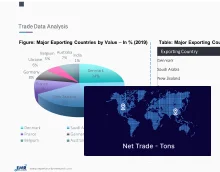
Get insights & trends for a competitive edge.
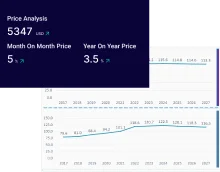
Track prices with detailed trend reports.
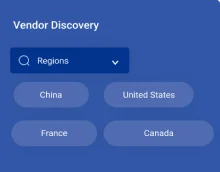
Analyse trade data for supply chain insights.
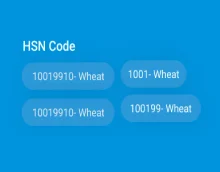
Leverage cost reports for smart savings
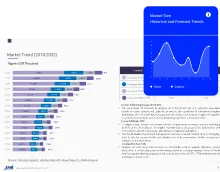
Enhance supply chain with partnerships.
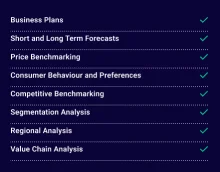
Connect For More Information
Our expert team of analysts will offer full support and resolve any queries regarding the report, before and after the purchase.
Our expert team of analysts will offer full support and resolve any queries regarding the report, before and after the purchase.
We employ meticulous research methods, blending advanced analytics and expert insights to deliver accurate, actionable industry intelligence, staying ahead of competitors.
Our skilled analysts offer unparalleled competitive advantage with detailed insights on current and emerging markets, ensuring your strategic edge.
We offer an in-depth yet simplified presentation of industry insights and analysis to meet your specific requirements effectively.
Share